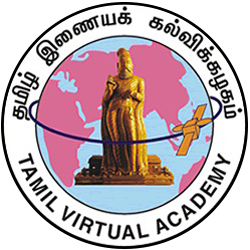Primary tabs
-
d04121 LESSON - 1
Classification of Epics - An IntroductionThis lesson offers an introduction to the classification of Tamil
Epics- i.e. ‘kappiangal.’ It traces the origin of Epic literature in Tamil;
discusses the salient features of Tamil epics; outlines the basis
of their classification; sums up the views of various Tamil scholars
on the classification of epics and presents a comparative study of epics
in various languages.An epic may be defined as a long poem that narrates the life and
adventures of a great hero. Tamil language has a rich tradition of epic
literature. Though there were no epics during the Sangam age, stories were
narrated to the accompaniment of music and were also performed on stage.
These stories were handed down from generation to generation by way of
the oral tradition. These stories were the forerunners of epic literature in
Tamil.‘Silapadigaram’ written by Elangovadigal is the first Tamil epic and
has several features of folk literature.There are many differences between Tamil Epics and their western counterparts. That epics should only speak of the 4 great themes, namely,
‘ aram’, ‘porul’ ‘inbam’ and ‘veedu’ is a rule underlying Tamil epics.
According to Prof. Vaiyapuri Pillai, epics may be based on stories from
‘ The Ramayana’ or ‘The Mahabarata’, or stories popular among the masses.
Dandiyasiriyar defines epic as a long poetic narrative that explores the
themes of ‘aram’, ‘porul’, ‘inbam’ and ‘veedu.’ Parimelazhagar, another
important Tamil scholar underscores the fact that epics can only speak
of the first three of the 4 great themes- namely. ‘aram’,‘porul’ and ‘inbam’.
However, the five great Tamil epics do not speak of all the 4 themes. The
lesson also outlines the views of western scholars Diliard and C.M.
Bowra on the characteristics of epic literature.There are many ways of classifying epics. Epics can be classified
on the basis of the theories expounded in the grammatical treatises such as
‘ Tholkappiam’ , ‘Nannool’ and ‘Dandialangaram’ or on the basis of the
classification of European and other Indian epics.Epics can be classified on the basis of the age in which they were
composed. Such a classification has several uses. It not only helps us
understand the social, political and cultural milieu of the age, but also
offers an insight into the popular literary theories of the age. Epics can
also be classified on the basis of the following factors: meter, those based
on Sanskrit epics, the age in which they were written, the characters, the
religious tenets espoused by the characters, the length and the number of
verses, and the various Tamil Kings during whose reign the epic may have
been written.The lesson discusses the classification of the 5 great Tamil epics
(aimperumkappiangal) and the 5 small Tamil epics (ainchirukappiangal)
on the basis of chronology.





